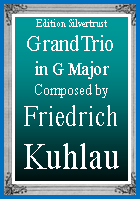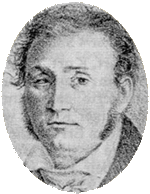Presents
Friedrich Kuhlau
|
Soundbites |
 |
 |
||
|
Flute, Cello & Piano |
Flute, Bassoon & Piano |
2 Flutes & Piano |
||
| 1st Movement | 1st Movement | 1st Movement | ||
Grand Trio in G Major, Op.119
For Flute, Cello or Bassoon and Piano / or Violin, Cello and Piano
Or 2 Flutes and Piano
One of Friedrich Kuhlau's last works, written in 1831, was his Grand Trio in G Major, Op.119. It was originally for two flutes but his publisher had an arrangement creating a cello or bassoon or bassoon part from the second flute part. This gives the cello or bassoon a greater role than one normally finds in trio music of this period, elevating it to an equal partner with the other instruments instead of barely beyond the bass line as is the case with most Classical and early Romantic trios. His publisher also added a violin part in place of the first flute so that the work could be played by the standard piano trio. Kuhlau's experience in opera composition is evident here in the song-like quality of the melodies and the coloratura-like technique given to all of the instruments. In the opening movement, Allegro moderato, the sentimental main theme is introduced by the piano. In the second movement, Adagio patetico, the Hungarian sounding middle section is particularly noteworthy. The finale is an upbeat Rondo.
Friedrich Kuhlau (1786-1832), often called the “Beethoven of the Flute”, is well-known to flute players, if few others, for the many fine pieces that he composed for that instrument. Though it is generally assumed, by those who have heard of him, that he was a flute virtuoso, ironically, he never played the instrument. Born in Germany, after being blinded in one eye in a freak street accident, he studied piano in Hamburg. In 1810, he fled to Copenhagen to avoid conscription in the Napoleonic Army, which overwhelmed the many small principalities and duchies of northern Germany, and in 1813 he became a Danish citizen. Outside of several lengthy trips which he took, he resided there until his death. During his lifetime, he was known primarily as a concert pianist and composer of Danish opera, but was responsible for introducing many of Beethoven’s works, which he greatly admired, to Copenhagen audiences. Considering that his house burned down destroying all of his unpublished manuscripts, he was a prolific composer leaving more than 200 published works in most genres. Beethoven, whom Kuhlau knew personally, exerted the greatest influence upon his music. Interestingly, few of Beethoven’s contemporaries showed greater understanding or ability to assimilate what the great man was doing than Kuhlau. Certainly with regard to form, Kuhlau was clearly able to make sense and use what Beethoven was doing in something as advanced as his Middle Period. Thus, for those encountering his chamber music for the first time, there is always a surprise at how fine the music is structurally and also how well he handles the instruments. Beyond this, he definitely had, like Mozart, Schubert or Hummel, a gift for wonderful melodies which bubble forth from his music effortlessly.
| (A) Flute, Cello or Bassoon & Piano-Parts | $29.95 |
|
| (B) Violin, Cello & Piano-Parts | $29.95 |
|
| (C) Two Flutes and Piano | $29.95 |
|
| (D) All Five Parts | $39.95 |
|